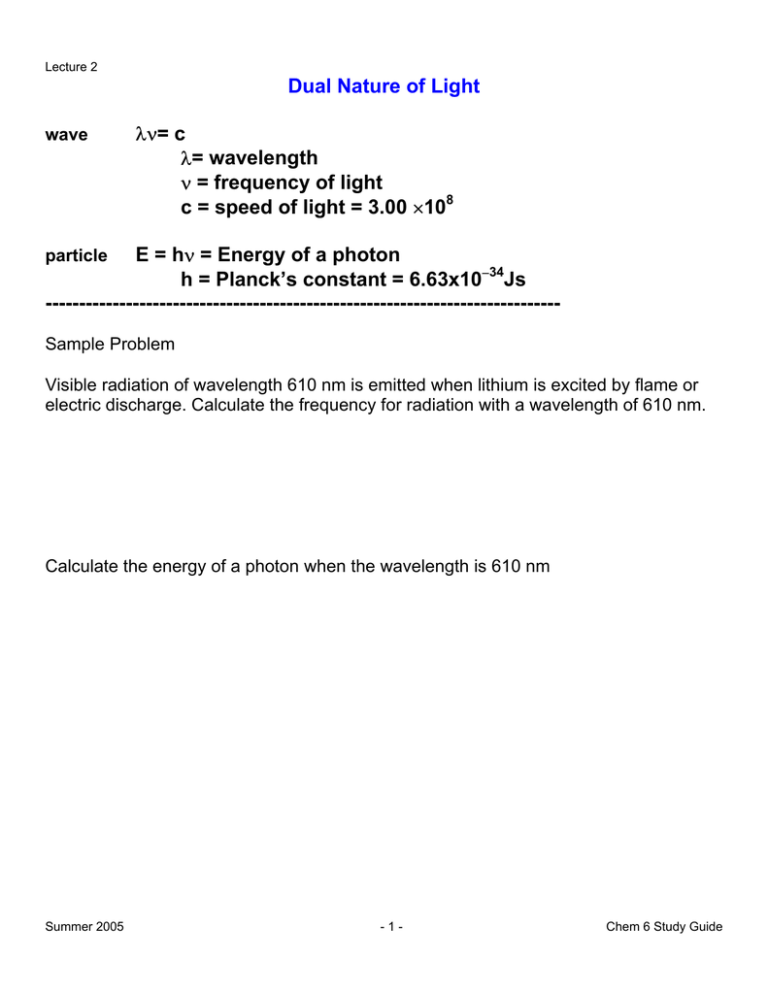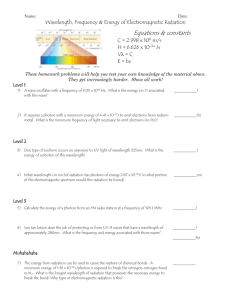Dual Nature of Light λν= c λ= wavelength ν = frequency of light c
advertisement

Lecture 2 Dual Nature of Light wave λν= c λ= wavelength ν = frequency of light c = speed of light = 3.00 ×108 E = hν = Energy of a photon h = Planck’s constant = 6.63x10−34Js ----------------------------------------------------------------------------particle Sample Problem Visible radiation of wavelength 610 nm is emitted when lithium is excited by flame or electric discharge. Calculate the frequency for radiation with a wavelength of 610 nm. Calculate the energy of a photon when the wavelength is 610 nm Summer 2005 -1- Chem 6 Study Guide Lecture 2 Bohr Model of H atom Energies of the allowed states of H atom are: ⎛ 1⎞ E n = − RH ⎜ 2 ⎟ ⎝n ⎠ n = 1, 2, 3, ….. principal quantum number RH = Rydberg constant = 2.18x10−18J Atoms absorb or emit light when e− changes its orbit or ∆E = E f − Ei = hν ⎛ 1 1 ⎞ hν = ∆E = RH ⎜⎜ 2 − 2 ⎟⎟ ⎝ ni n f ⎠ where ni and nf are integers. This predicts the H-atom spectrum EXACTLY! nf > ni ∆E is + (absorbs photon) ∆E is − (emits photon) nf < ni ------------------------------------------------------------------------------------------ Note: Sample Problem When an electron in the hydrogen atom changes from n = 5 to n = 1, what is the energy of the photon involved? Is a photon emitted or absorbed? Summer 2005 -2- Chem 6 Study Guide Group Problems Light and the Bohr Model 1. Name ____________________ A quantum of electromagnetic radiation has a wavelength equal to 7.52 × 106 Å. What is the frequency of this radiation in cycles/sec? (a) 1.13 × 10−12 (b) 8.80 × 10−26 (c) 3.99 × 10+11 (d) 9.45 × 10+13 (e) 2.69 × 10−15 HINTS Convert the wavelength in Å to meters. Be sure to include units and show how they cancel in the process of solving the problem. 2 Calculate the energy in joules of 1 mole of 675 nm photons. (a) (b) (c) (d) (e) 3. What is the wavelength of the radiation when an electron in the Hydrogen atom goes from n= 5 to n=1 level? (Use the information about the energy of the photon (demonstration problem) to calculate the wavelength.) (a) (b) (c) (d) (e) 4. 2.25 x 10−15J 2.94 x 10−19J 1.99 x 10−25J 1.77 x 105J 675J 91 nm 114 nm 95 nm 456 nm 2280 nm When an electron changes from n = 6 to n = 2, is the energy change greater than or less than the energy change that occurs when the electron goes from n = 5 to n = 1? (Can you answer this without actually calculating the energy change?) Summer 2005 -3- Chem 6 Study Guide




